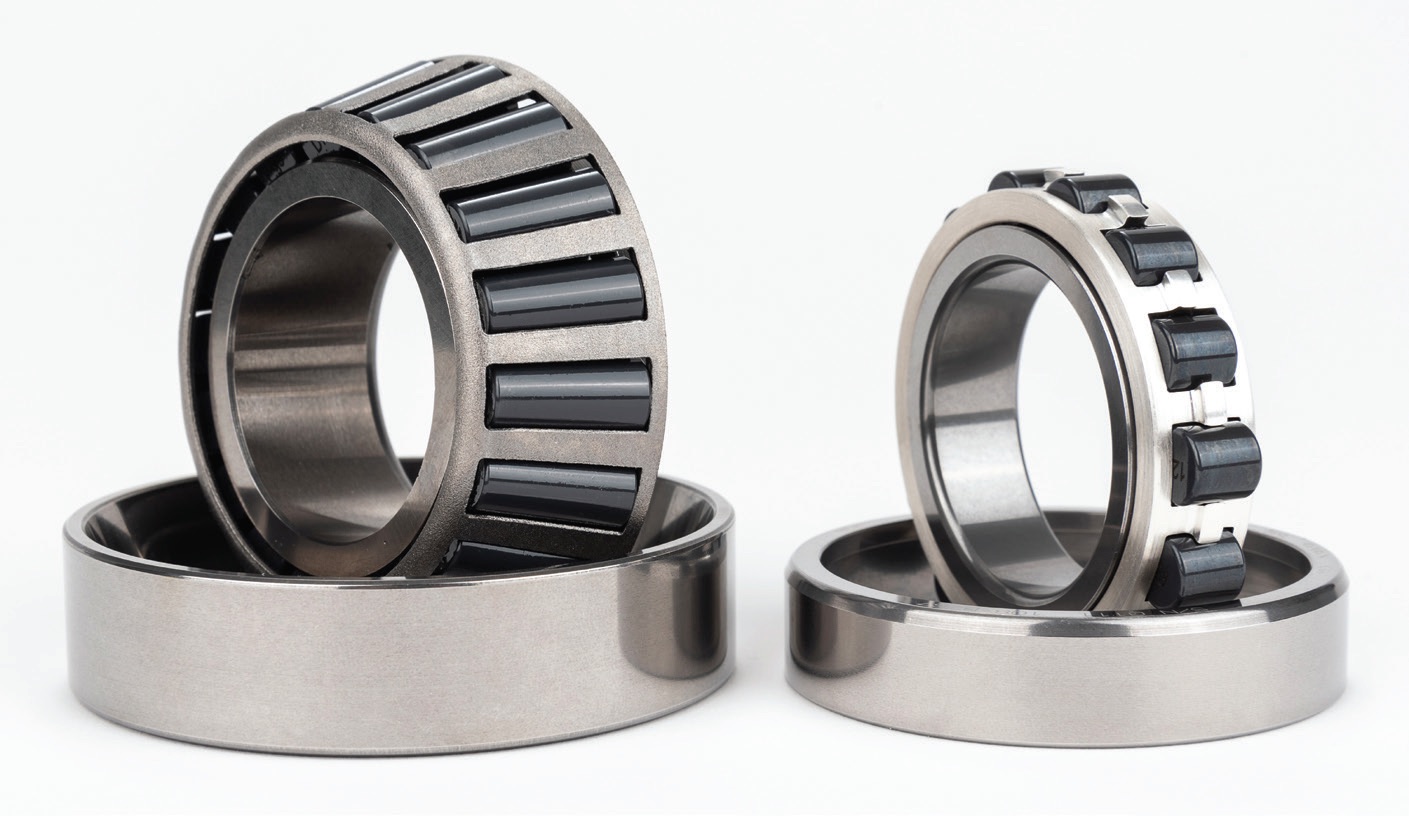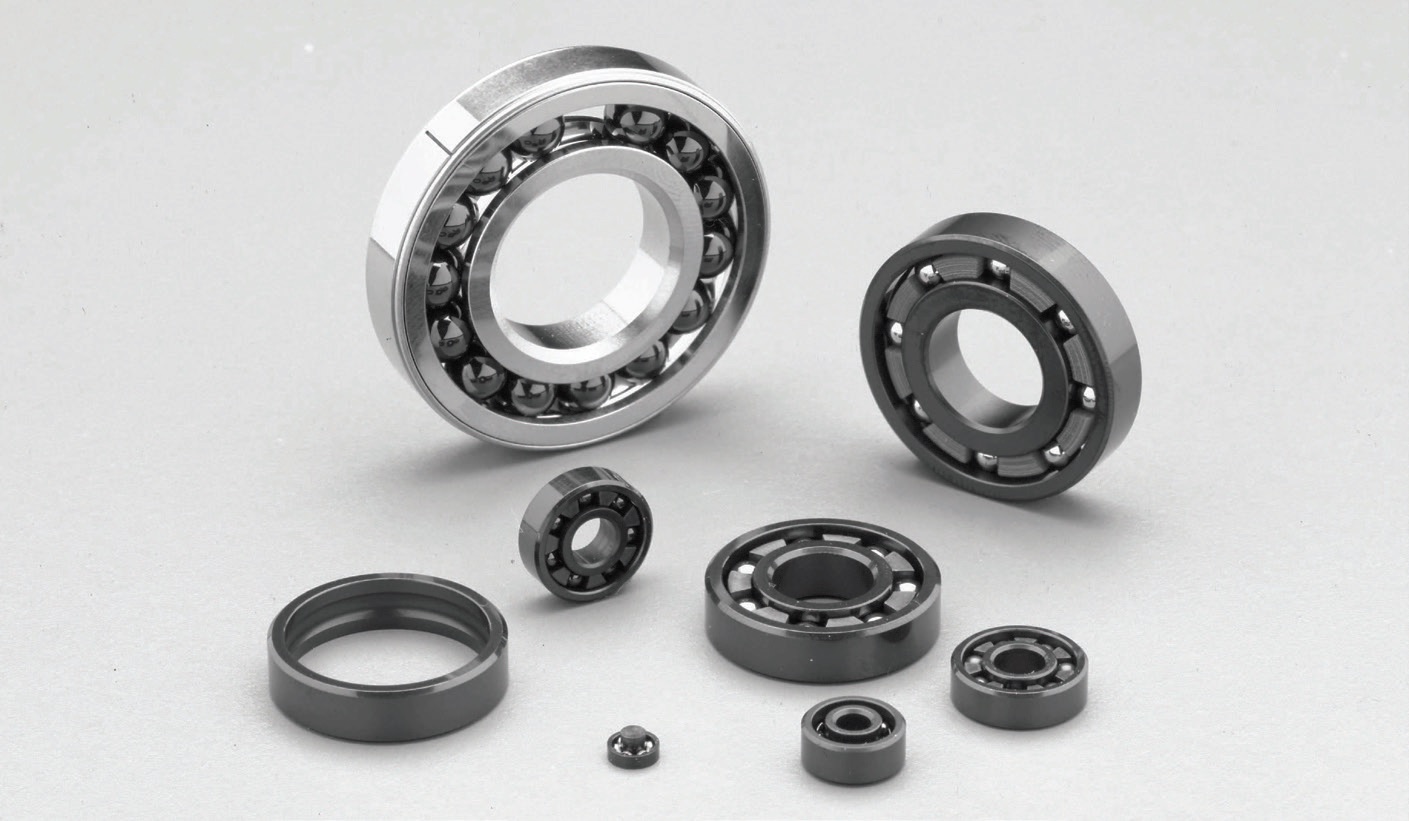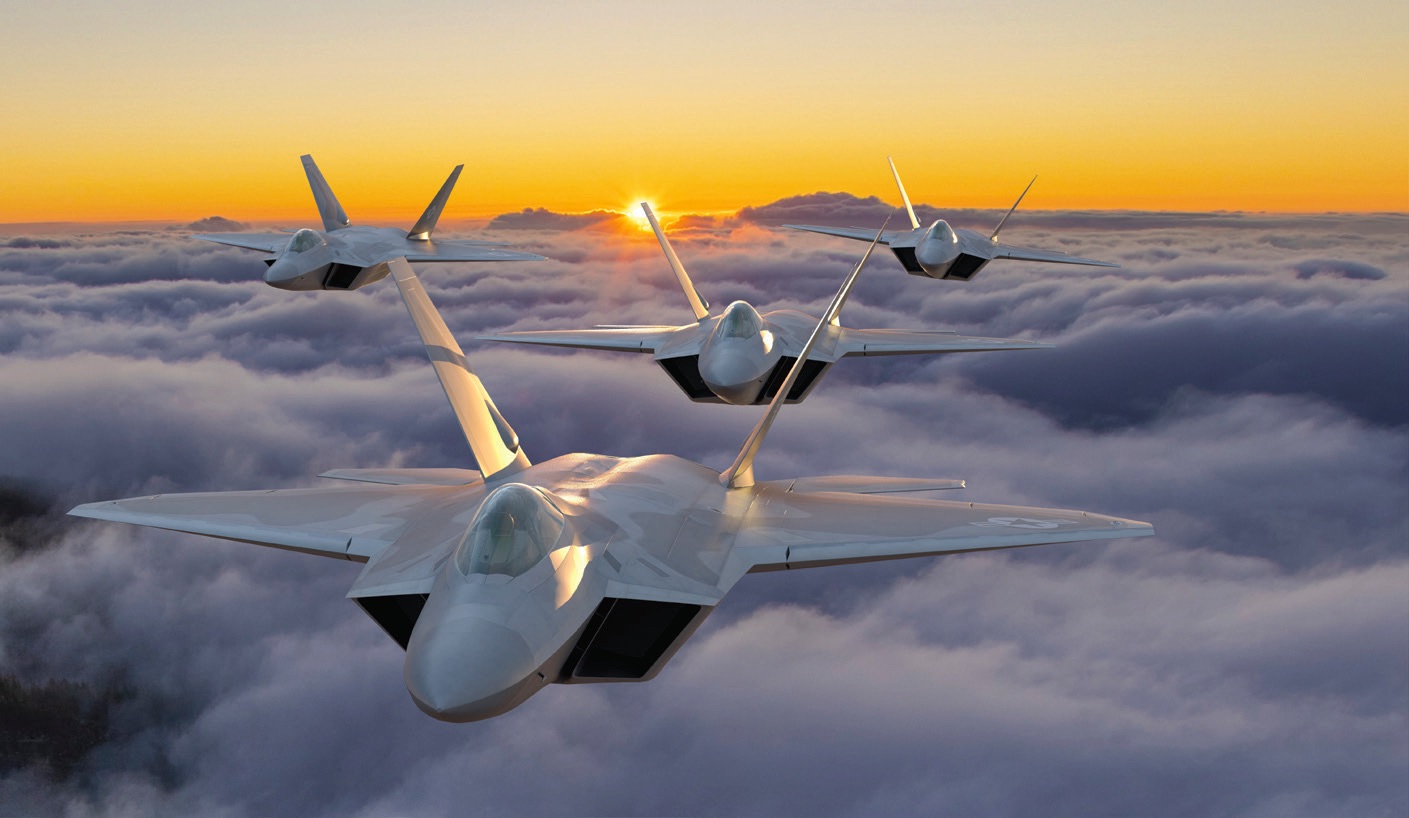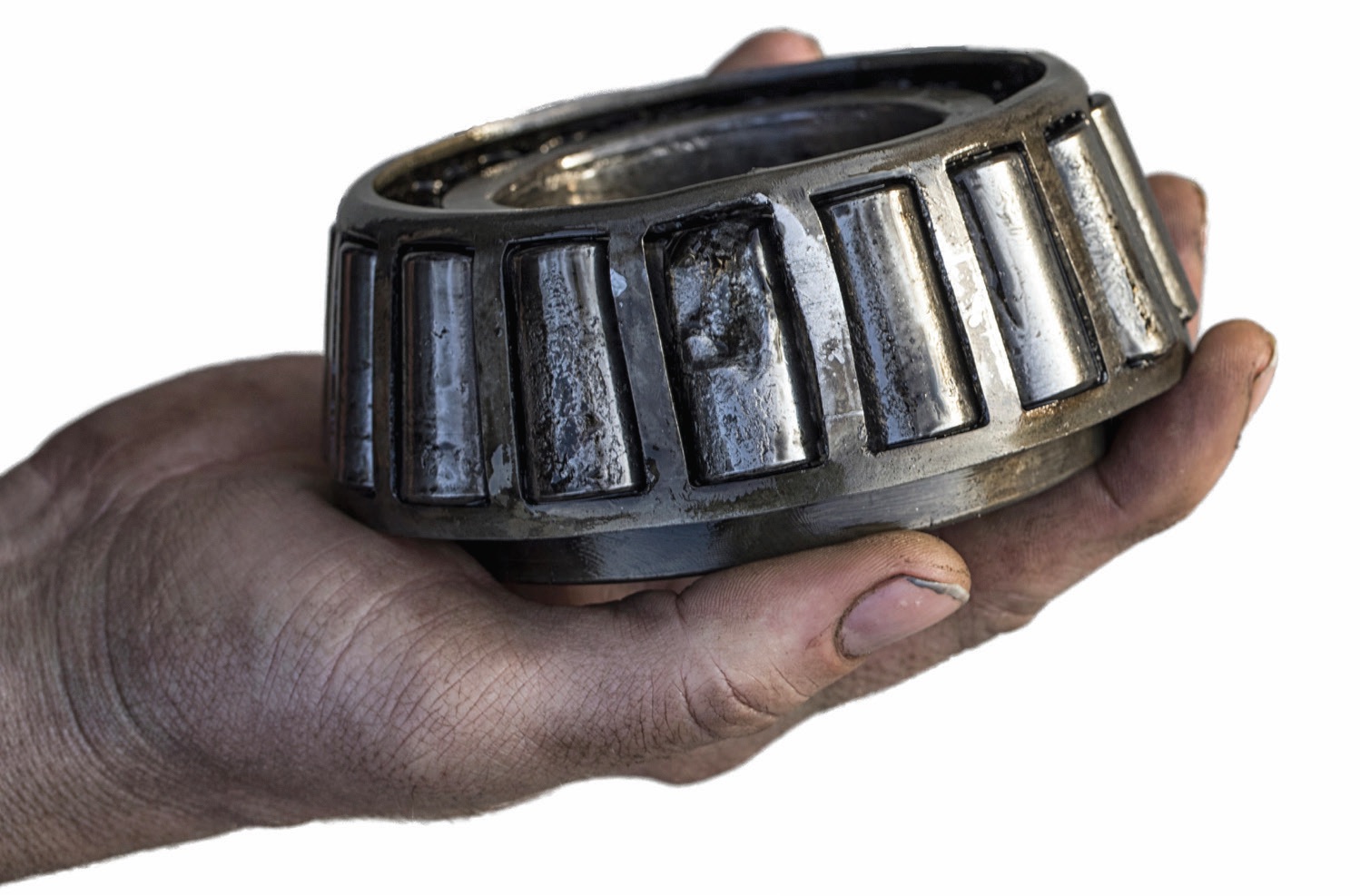KEY CONCEPTS
•
Hybrid bearings have unique characteristics such as electrical insulation and light weight that align well with trends such as the expected prevalence of electric vehicles and increased space exploration.
•
Despite the fact that they are more expensive than all-steel bearings, hybrid bearings also are a good choice for thin-film/low-lubrication application conditions.
•
One of the issues with hybrid bearings has been a relatively short, predicted fatigue life. However, updated calculations challenge that assumption.
Hybrid bearings are rolling element bearings that are composed of steel rings and ceramic rolling elements. The most commonly used ceramic ball and roller material is silicon nitride (Si
3N
4). Test data shows that hybrid bearings perform better than all-steel bearings in some applications, including those with thin-film and contaminated lubrication conditions.
While hybrid bearings seem to have a shorter predicted rolling contact fatigue (RCF) life than all-steel bearings, experts say the methods used to calculate steel bearing life are not wholly applicable to hybrid bearings. Since the commonly used Lundberg-Palmgren
1 (LP) RCF model is based on conventional AISI 52100 bearing steel used for races and rolling elements, it cannot truly model the fatigue behavior of hybrid bearings. Fortunately, the RCF modeling capabilities being developed today can better predict the performance of hybrid bearings under varying lubrication conditions.
Silicon nitride materials were first incorporated into conventional rolling element bearings almost 50 years ago. Since then, the techniques for manufacturing high-quality silicon nitride rolling elements have significantly advanced; silicon nitride rolling element failures for properly engineered hybrid bearing applications are extremely rare.
More recent developments include hybrid tapered rolling element bearings and hybrid cylindrical rolling element bearings for applications requiring more load capacity (
see Figure 1). Today, hybrid bearings have been adopted in a wide range of applications—from small dental drills to rotorcraft to space satellites—and even many components within the NASA Mars rover Curiosity.
 Figure 1. Hybrid tapered roller bearing (left) and hybrid cylindrical roller bearing (right). Figure courtesy of The Timken Co.
Advantages over all-steel bearings
Figure 1. Hybrid tapered roller bearing (left) and hybrid cylindrical roller bearing (right). Figure courtesy of The Timken Co.
Advantages over all-steel bearings
Silicon nitride material offers several key advantages over traditional bearing steels. It is smoother, less chemically reactive, lighter and harder with a lower coefficient of thermal expansion. The lower density results in lower centrifugal forces on the rolling elements, which results in lower contact stress at high speeds. Its higher modulus of elasticity results in a smaller contact area, which can contribute to better tribological behavior and lower heat generation.
Hybrid bearings maintain their strength and corrosion resistance over a much wider temperature range than all-steel bearings. Silicon nitride also is electrically insulating and eliminates damage from electric arcing. This property makes hybrid bearings a logical choice for electric vehicles.
STLE and ASME Fellow Dr. Pradeep K. Gupta, president, PKG Inc., Clifton Park, N.Y., explains, “The single most important characteristic that a hybrid bearing offers over an all-steel bearing is the interaction at the rolling element to race contacts. This is most fundamental to rolling bearing behavior. The reduced heat generation in hybrid contacts and the resulting improvements in overall tribological behavior lead to a notable improvement in overall behavior of hybrid over all-steel bearings.”
STLE member Dr. Nikhil Londhe, product development specialist at The Timken Co., North Canton, Ohio, summarizes benefits this way: cooler operation, highspeed capabilities, debris resistance, oil-off performance, corrosion resistance, low torque, high precision, high stiffness and a non-magnetic and non-conductive nature.
“These characteristics are desirable in many applications,” Londhe adds. “Electric arcing damage can occur when electric current that passes through the bearing is broken at the contact surfaces between races and rolling elements. Hybrid bearings are recommended in such applications because silicon nitride material is electrically insulating and can eliminate the risk of electric arcing damage. Hybrid bearings with duplex-hardened, nitride steel raceways offer many advantages in difficult applications.”
According to Londhe, when compared to all-steel bearings, tests of hybrid bearings with nitrided raceways show these bearings perform better in high speed, high temperature, thin-film lubrication and contamination conditions. Since silicon nitride rolling elements also are lighter when compared to steel rolling elements, hybrid bearings are good alternatives in transmissions where the overall weight of the system is critical.
Disadvantages over all-steel bearings
On the other hand, the brittle nature of the ceramic materials that make up hybrid bearings demands greater precision in material manufacture in order to reduce the risk of inducing flaws, which can limit the use of these materials in certain applications. More significantly, the contact stress in a hybrid bearing is greater than that of an all-steel bearing for a given load and contact geometry. The increased stress can result in accelerated fatigue—but just how much is not always clear.
Gupta observes, “Although the higher contact stress at a prescribed load does lead to a reduction of (predicted) fatigue life of the contact, a systematic parametric evaluation of internal bearing geometry of hybrid bearings may be carried out to optimize the design for improved thermal behavior, overall dynamics and bearing life.”
Londhe agrees and offers workarounds. “Even though hybrid bearings have many advantages, some attributes of silicon nitride material need special consideration in designing,” he says. “Silicon nitride material has a higher elastic modulus than bearing steels, so under the same load and geometry, contact between silicon nitride rolling elements and steel raceways is smaller than contact between steel rolling elements and steel raceways. Therefore, hybrid contacts operate under higher contact pressure when compared to steel counterparts under the same bearing load. Designers can compensate for this by modifying raceway geometry parameters or by selecting stronger, and/or better-quality steel for raceways.”
Londhe notes other issues. “Silicon nitride has a lower thermal expansion coefficient than steel,” he says. “This means that if a hybrid bearing is operating over a wide temperature range, then the internal clearance inside the bearing will vary with temperature. Changes in internal clearance can alter preload and contact angles inside hybrid bearings. This phenomenon needs to be considered in the application modeling of hybrid bearings.”
Silicon nitride rolling elements also are more expensive than their all-steel counterparts, making them more likely a consideration only in applications where all-steel bearings cannot provide the desired performance.
Design and manufacture
“Hybrid ball bearings (
see Figure 2) and hybrid roller bearings have different geometries; therefore, the challenges related to the development and manufacturing of these bearings are different,” Londhe notes. “Roller bearings make use of special profiles to minimize the adverse effect of edge stresses. Special tooling is required to develop these profiles in roller bearings. For hybrid ball bearings, higher contact stresses due to the increased stiffness of silicon nitride ball material can be compensated for by raceway geometry modifications. Designers need to consider bearing performance parameters of interest when applying geometry modifications.”
 Figure 2. Hybrid ball bearing. Figure courtesy of The Timken Co.
Figure 2. Hybrid ball bearing. Figure courtesy of The Timken Co.
Ceramic roller bearings were introduced in the 1980s. “To develop special profiles on ceramic rolling elements, an ultra-precision dressing unit and special tooling are required,” Londhe says. “Manufacturing processes have evolved since the early 1990s. The current finishing process ensures high-quality ceramic rollers that provide reliable performance in applications.”
Londhe explains that ceramic material, being brittle, is at higher risk of cracking than steel during manufacturing. Improper manufacturing processes can create cracks on the surface or near surface regions of silicon nitride rolling elements. Since rolling contact fatigue loads are concentrated over a small volume of material, the rolling elements can experience catastrophic failures from these cracks if they are exposed to application loads in service. In addition, optical inspection procedures to detect these cracks in manufacturing are complicated due to the nonconductive and slightly translucent characteristics of ceramic material.
2 Ceramic rollers also have stricter flaw size acceptance criteria than their steel counterparts.
“To minimize testing time, bearings are generally tested in accelerated rolling contact fatigue test conditions,” Londhe says. “Early experiments in the 1980s on hybrid bearings under these test conditions showed significant damage to silicon nitride balls that were poorly manufactured. Therefore, the quality of the silicon nitride material is very critical for hybrid bearings to perform reliably under different test conditions.”
Londhe continues, “There is interest in the research community in analyzing the influence of carbides on contact stresses experienced by case-hardened raceways. To reliably predict bearing endurance in applications, a fundamental knowledge of interactions between the microstructural attributes of bearing steel and service loads is necessary. Only such a science will pave the way for mechanics and material science-based methods for bearing life prediction.”
Londhe adds, “There are different ways to model microstructural level interactions between rolling elements and raceways.” In a recent research paper (co-authored by Londhe),
3 easy-to-use closed-form solutions were developed that designers can use to analyze contact stresses between steel or silicon nitride rolling elements and case hardened raceways. Bearing life estimates become more reliable when the material microstructural details are taken into account in fatigue life prediction models.
“In another work, we have developed a novel method for analyzing bearing fatigue life data using a Bayesian updating technique.
4 You can compare Bayesian updating to a Google search: Results that you see are based on past knowledge of your searches and current trends on that topic. When we applied such an advanced and powerful data analytics technique to existing data available in published literature, new insights on the fatigue endurance of bearing steels were found.” For this work, Londhe won STLE’s 2017 Walter D. Hodson Award.
“Contact geometry and stress are the two basic parameters that define the behavior of a concentrated rolling/sliding contact,” Gupta says. “Since a hybrid contact alters both of these parameters, the effect on resulting traction and, hence, the overall dynamics is immediate.”
He continues, “In addition to a significantly higher modulus of elasticity, thermal behavior of ceramic materials is very different from that of steel. This leads to greatly altered internal bearing clearances and contact stiffness. Thus, a complete redesign of internal geometry of the bearing is warranted in hybrid bearings. Aside from modification of the initial radial clearance, a rigorous evaluation of race curvatures is essential in the design of hybrid ball bearings.”
Applications
Since, in most precision applications, improved dynamic and thermal performance often have a higher priority over classical fatigue, hybrid bearings with ceramic rolling elements have become increasingly popular in aerospace and machine tool applications over the last 30 years. Other applications include electric generators and dental drills.
High-speed, high-load, high-temperature applications in gas turbine engines, particularly for defense applications, is another area where the use of hybrid bearings has been explored recently. In particular, decades of laboratory research have resulted in strong data supporting the use of hybrid rolling element bearings and components in aircraft gas turbine engines. Materials such as silicon carbide, silicon nitride, alumina and titanium carbide have been tested for properties that include endurance.
In general, research on hybrid bearings in gas turbines has shown:
•
Silicon nitride materials produce the longest life of the materials studied. But the dynamic capacity is significantly less than that of a comparable all-steel bearing.
•
Bearings with ceramic rolling elements and steel races can have a shorter life than all-steel bearings.
•
Bearing heat generation and power loss (friction) are more closely related to bearing design than to material.
•
Non-lubricated silicon nitride bearings need lubrication at higher temperatures.
•
Custom design and mounting are needed to accommodate a full-complement ceramic bearing in turbomachinery.
STLE and ASME Fellow Erwin V. Zaretsky is a consulting engineer in Chagrin Falls, Ohio. He retired from NASA Glenn Research Center as chief engineer for structures and materials. He also is a pioneer in the development of an alternative calculation of fatigue life in hybrid bearings.
He reports that research at NASA has demonstrated that, in rocket engine turbopump applications where the cryogenic fluid flows through the bearings and no lubricant can be supplied to enhance the tribological behavior, hybrid bearings provide greatly improved performance. “However, since both bearing heat generation and life have to be optimized for these applications, development of acceptable hybrid bearings for these applications remains a challenge,” he clarifies.
Although Zaretsky has not been directly involved in most NASA programs that incorporate hybrid bearings for space applications, he has been called in as a consultant. He points out that hybrid stainless steel bearings were successfully used in both the oxygen and hydrogen-turbopumps in the NASA Space Shuttle program. This success helped encourage other applications.

Tribological benefits of hybrid bearings
According to Gupta, the single most important parameter for controlling the dynamics of a rolling bearing is lubricant traction. He explains that as the rolling elements travel between the two races of a rolling bearing, traction behavior at the concentrated contact between the rolling element and race is the first interaction that alters motion of the rolling elements. This affects the motion of the cage and the overall dynamics of the bearing.
He adds that in spite of dissimilar properties, recent studies also have shown increased compatibility between ceramic and steel materials. The improved tribological match leads to less friction and wear in hybrid contacts than all-steel contacts.
“Such improvements in tribological performance lead to better durability of hybrid bearings than all-steel bearings under thin-film and contaminated lubrication conditions,” Gupta says. “This makes hybrid bearings a good choice for thin-film/low-lubrication application conditions.”
Londhe agrees. “Hybrid bearings tend to perform better than all-steel bearings in thin-film lubrication conditions,” he says. “Spalling in rolling element bearing components can initiate on the surface or in the subsurface region. Under a thin-film lubrication condition between the rolling elements and raceways, surface-initiated damage is commonly observed. For steel-on-steel contacts, adhesive wear dominates, but for contact between silicon nitride and steel raceways, such damage is less severe due to dissimilar material properties.
5
“A metal-ceramic combination shows a lesser wear rate than metal-metal or ceramic-ceramic combinations. Therefore, metal-ceramic combinations are used for tribo-elements in modern advanced machine systems.”
6
He concludes, “Over the past 30 years, well-controlled rolling contact fatigue tests have shown consistently superior performance by hybrid bearings over their all-steel counterparts in thin-film lubrication conditions.”
Bearing fatigue and failure
While no bearing—hybrid or all-steel—delivers perpetual service, less than 5% of bearings removed from service for cause are removed solely because of bearing failure. Environmental factors such as moisture and dirt that lead to corrosion are more likely causes. However, even bearings that are effectively protected, lubricated and properly cared for are still subject to rolling element fatigue at some point.
This fatigue exhibits as flaking that starts as a crack and develops into spalling on a load-bearing surface. While fatigue is ultimately unavoidable, the number of revolutions the bearing makes before the initiation of flaking and spalling depends on the bearing load.
The term “life” signifies the period of performance that is limited by fatigue. It is measured in the number of bearing revolutions or the number of operating hours at a given rotation speed. The “L
10 life” is the length of operating time that 90% of a group of bearings will exceed without failing because of fatigue. L
10 life is the standard for calculating bearing reliability and longevity.
Regarding the significance of bearing failures due to fatigue, Zaretsky explains, “A rolling element fatigue failure is equivalent to a person dying of old age. Hence, the question could be asked, ‘How significant is it, in terms of human life span, for a person to die of old age?’ As disease is conquered and controlled, old age (read fatigue) becomes more significant.”
Zaretsky and Emanuel Branzai addressed this question as it pertains to bearings in an STLE Tribology Transactions article.
7 “We used data from approximately 224,000 commercial engine bearings removed from service on or before 20,000 hours for rework,” Zaretsky says. “Of these bearings, 1,977 or 0.88% failed from fatigue. We calculated that the probable L
10 fatigue lives (90% probability of survival, old age) were well over 100,000 hours.”
Using field data from J.S. Cunningham, Jr. and M.A. Morgan from the Naval Air Rework Facility,
8 fatigue accounted for 3% of the bearings removed from service. Several other causes accounted for the removal of the remainder.
“This, in my opinion, is like saying that only 3% of bearings live to old age,” Zaretsky says. “The potential fatigue lives of rolling element bearings today are approximately 40 times greater than those of pre-1960. Hence, if fatigue can be designed around or we can prevent the other causes for bearing removal, operating bearing usage can be significantly increased and costs reduced.”
 Calculation of fatigue life for hybrid bearings
Calculation of fatigue life for hybrid bearings
While at NASA, Zaretsky carried out fatigue testing of silicon nitride balls. “The limitations in generating experimental life data for full-scale hybrid bearings are money and time,” he explains. “Actually, to their credit, the U.S. Air Force Research Laboratories at Wright-Patterson Air Force Base in Dayton, Ohio, carried out and published data of full-scale hybrid bearings around 2017,” he says. Gupta and Zaretsky referenced and used those results in their 2019 Tribology Transactions article, “Life Model Enhancement for Hybrid Ball Bearings.”
9
Regarding the 2019 research article,
10 Gupta explains, “In this recent work, experimentally generated life data on silicon nitride balls is used to develop a discrete life equation for silicon nitride rolling elements. This formulation is then implemented into the generalized fatigue life formulation for rolling bearings where lives of both races and rolling elements are first modeled individually and then statistically combined to predict the life of the entire bearing. Such an implementation of realistic behavior of ceramic materials leads to improved life prediction for hybrid ball bearings.”
Hybrid bearing materials change the bearings’ dynamic behavior. Gupta and Zaretsky’s method of calculation showed that the fatigue life of hybrid bearings was significantly greater than that calculated by the LP method.
Based on the available experimental data on the rolling contact fatigue life of silicon nitride balls, the rolling element life model was enhanced in the generalized fatigue life models developed by Gupta and Zaretsky.
11
Based on the Gupta-Zaretsky analysis, at the normal stress levels to which bearings are expected to be operated, the silicon nitride balls or rollers would not be expected to fail from rolling element fatigue.
According to Zaretsky, only the steel bearing raceways would be expected to fail from fatigue in a shorter time than a steel-on-steel bearing. However, at higher speeds, it is a possibility, depending on the application, that the steel races of a hybrid bearing also can have a longer life than an all-steel bearing.
Until recently, the majority of rolling bearing life estimates in practical bearing designs has been based on the original LP model. This formulation derives from unpublished experimental fatigue life data for a large number of bearings made with pre-1950 AISI 52100 bearing steel. The LP model is based on Weibull’s fatigue hypothesis, which relates the fatigue life to an integral of a subsurface stress function over the stressed volume.
By relating the subsurface critical failure stress and stressed volume to the bearing geometry, the LP life equation expresses life simply in terms of geometrical parameters of the bearing, with properties of the AISI 52100 steel being part of the empirical constant. In addition, the shear stress exponent in the stress function is included as part of other exponents in the life equation, and bearing life is segmented into outer and inner race lives only, with no provision for an independent treatment of rolling element life.
The Gupta-Zaretsky enhanced ball life equation is correlated to the generalized life equations for the races to develop a more accurate life prediction model for a hybrid ball bearing. Life predictions with the enhanced model for hybrid bearings agree with the experimental findings.
In order to more effectively implement the LP life model to rolling bearings with arbitrary bearing materials, Gupta and Zaretsky developed a generalized form of the LP equation in terms of distinct material and geometrical parameters. The empirical constant, which is estimated by correlation of model predictions with experimental bearing life data, is independent of material properties. In addition, independent life equations for the races and rolling elements are presented, where the empirical exponents and constants may be arbitrarily modified to better model the behavior of the race and rolling element materials. This newly introduced model makes three fundamental modifications to the LP equation:
1.
Explicit life dependence on subsurface depth of the failure stress is eliminated.
2.
The maximum subsurface orthogonal shear stress used by Lundberg and Palmgren is replaced by the maximum subsurface shear stress.
3.
Data variability in the stress-life exponent is eliminated.
With these modifications, the new Gupta-Zaretsky model better conforms to the original Weibull postulation, and life predictions obtained for hybrid bearings show improved agreement with the experimental findings.
Londhe says, “The topic of rolling element bearing life prediction has interested many generations of researchers. Over the past three or four decades, many researchers and scientists have made significant contributions in the field. Bearing manufacturers have developed methods based on their internal test results.”
Conclusions
Although they may be more expensive and there is still uncertainty regarding fatigue performance, hybrid ball and roller bearings have distinct advantages over all-steel bearings in specific applications—the most promising areas being aviation, aerospace and electric vehicles. As the design and manufacturing process continues to be refined, and new research continues to better quantify properties, new opportunities will open up.
Zaretsky concludes, “The issue becomes whether future engine applications and operation would require and be enhanced by the use of these bearings. That is an open question.
At the speeds and temperatures that current commercial gas turbine engines operate, in my opinion, the use of hybrid bearings do not offer a technical, operational or financial advantage,” He adds that it may change if new technology is shown to benefit from the properties of hybrid bearings.
REFERENCES
1.
In 1947 and 1952, Gustaf Lundberg and Arvid Palmgren developed what is now referred to as the Lundberg-Palmgren model for predicting rolling bearing life. The formula is based on classical rolling element fatigue theory.
2.
Levesque, G.A. and Arakere, N.K (2010), “Critical flaw size in silicon nitride ball bearings,”
Tribology Transactions, 53 (4), pp. 511-519.
3.
Londhe, N.D., Arakere, N.K. and Subhash, G. (2018), “Extended hertz theory of contact mechanics for case-hardened steels with implication for bearing fatigue life,”
ASME Journal of Tribology, 140, 021401-1-11, DOI:10.1115/1.4037359.
4.
Londhe, N.D., Arakere, N.K. and Haftka, R.T. (2015), “Reevaluation of rolling element bearing load-life equation based on fatigue endurance data,”
Tribology Transactions, 58 (5), pp. 815-828, DOI:10.1080/10402004.2015.1021943.
5.
Hager, C.H., Doll, G.L., Evans, R.D. and Shiller, P.J. (2011), “Minimum quantity lubrication of M50/M50 and M50/Si3N4 tribological interfaces,”
Wear, 271 (9-10), pp. 1761-1771.
6.
Bhushan, B. (2000),
Modern Tribology Handbook – Volume Two, CRC Press, Boca Raton, Fla.
7.
Zaretsky, E.V. and Branzai, E.V. (2016), “Rolling bearing service life based on probable cause for removal - A tutorial,”
Tribology Transactions, 60 (2), pp. 300-312.
8.
STLE Lubrication Engineering,
35 (8), pp. 435-441.
9.
Pradeep, K., Gupta, P. and Zaretsky, E.V. (2019), “Life model enhancement for hybrid ball bearings,”
Tribology Transactions, 62 (6), pp. 1129-1141, click
here.
10.
Ibid.
11.
Ibid.
Jeanna Van Rensselar heads her own communication/public relations firm, Smart PR Communications, in Naperville, Ill. You can reach her at jeanna@smartprcommunications.com.